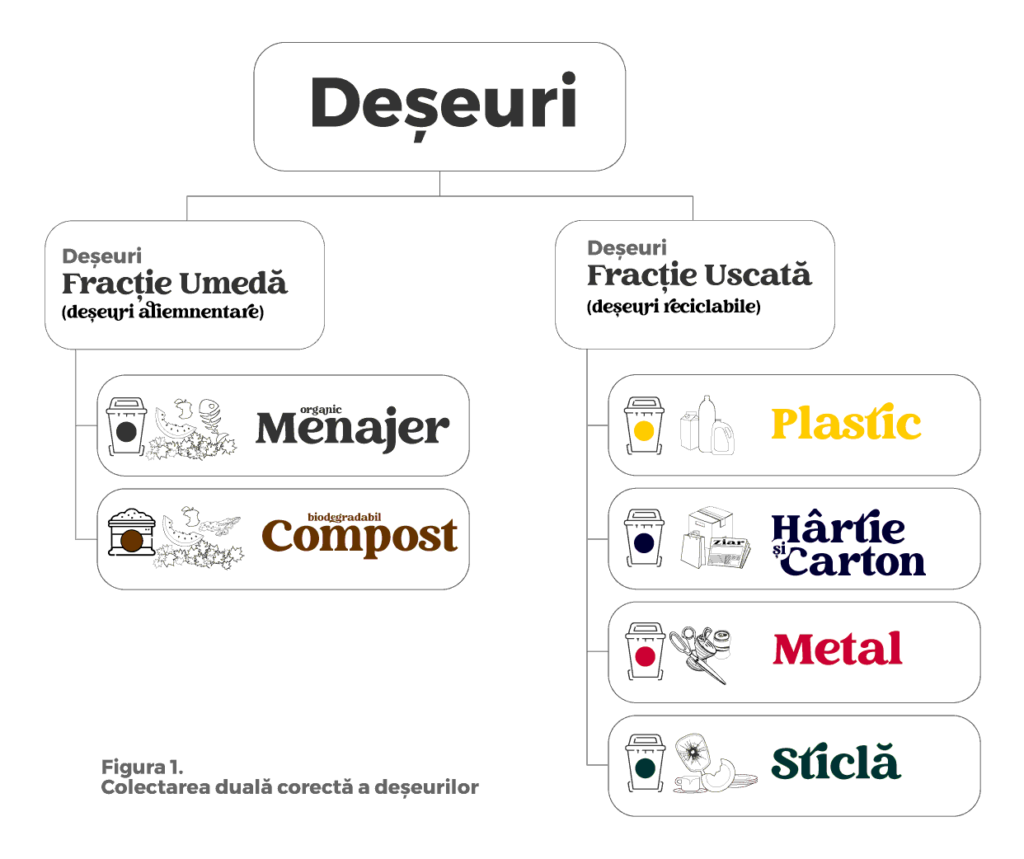
What does dual waste collection mean
Dual collection involves the collection of waste in two distinct containers, one for the wet fraction and one for the dry fraction.
WET FRACTION: it contains ordinary household waste, food scraps or those resulting from the production of daily food, as well as material that can no longer be recycled, impregnated with oil or wet, stained with food scraps, etc.
DRY FRACTION: it includes waste from the category of recyclable materials – paper, cardboard, PET, plastic bags, packaging films, aluminum cans, clean metal cans, bottles and jars emptied of Contents and washed if necessary, clean plastic packaging from hygiene products, etc.

Sorting and collecting waste is important to reducing our environmental impact. How can we do this right? See below:
HOUSEHOLD WASTE IN 2 FRACTIONS*
A. Wet Fraction: Residual Waste, Mixed*
Residual waste is the totality of waste that cannot be recycled.
This waste is stored in Black dumpster (or appropriately inscribed), intended for the collection of household waste.

YES:
NO:
A. Wet Fraction: Biodegradable Waste*
Biodegradable waste is the waste from which compost can be obtained, an excellent fertilizer for the plants around the house and for the soil in the garden or for the flowers in the apartment.
This waste is stored in Composter or Black dumpster (appropriately inscribed)

YES:
NO:
B. Dry Fraction: Recyclable Waste*
Plastic waste is collected in The Yellow Dumpster (appropriately inscribed)
In order to reduce the volume of waste and optimize the space, it is recommended to fold/fold this waste before disposing of it in dumpsters.

YES:
NO:
B. Dry Fraction: Recyclable Waste*
Waste paper and cardboard shall be collected in The Blue Dumpster (appropriately inscribed)
In order to reduce the volume of waste and optimize the space, it is recommended to fold/fold this waste before disposing of it in dumpsters.

YES:
NO:
B. Dry Fraction: Recyclable Waste*
Metal waste is collected in The Red Dumpster (appropriately inscribed)
In order to reduce the volume of waste and optimize the space, it is recommended to fold/fold this waste before disposing of it in dumpsters.

YES:
NO:
B. Dry Fraction: Recyclable Waste*
Glass waste is collected in The Green Dumpster (appropriately inscribed)
In order to reduce the volume of waste and optimize the space, it is recommended to fold/fold this waste before disposing of it in dumpsters.

YES:
NO:
Other types of waste*
Bulky waste-carpets, carpets, pieces of furniture, duvets, mattresses, etc.
Waste from demolition and construction – Earth from excavation, rubble, concrete, sanitary equipment, tiles, faience, gravel, concrete, carpentry, etc.
Waste Electrical, Electronics and household appliances – refrigerators, washing machines, televisions, kitchen robots, power tools, telephones, computers and peripherals, etc.
Why Collect separately:
We comply with the obligations provided by the legislation in force
We conserve non-renewable natural resources. Adopting environmentally responsible behavior must be part of our education!
We reduce the consumption of raw materials and, implicitly, the cost of making products!
* This information is just a few examples recommended by Toreco SRL . For full details of selective collection, see current legislation.
Sources:
Law no. 209/2016 on waste (Official Gazette of the Republic Of Moldova, 2016, no. 459-471, art. 916)
Government decision no. 561/2020 - regulation on packaging and packaging waste, published in the Official Gazette No. 212-220 art. 743, 21.08.2020
Government decision 301 of 24.04.2014 on the approval of the environmental strategy for 2014-2023 and of the action plan for its implementation
Government decision 248 of 10.04.2013 on the approval of the Waste Management Strategy in the Republic Of Moldova for the years 2013-2027